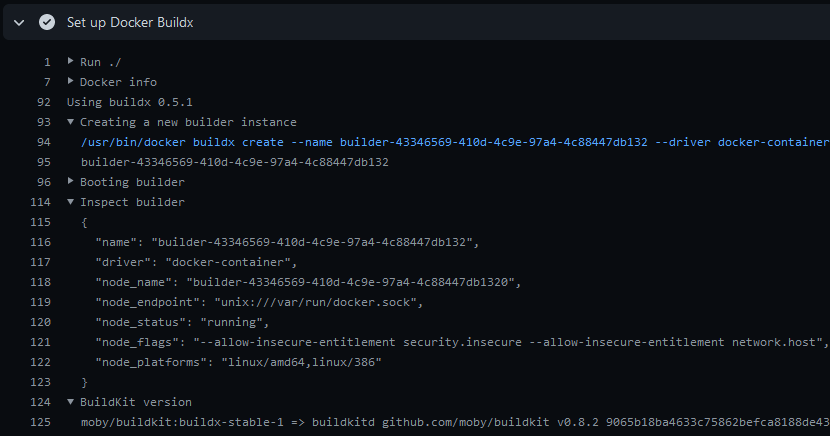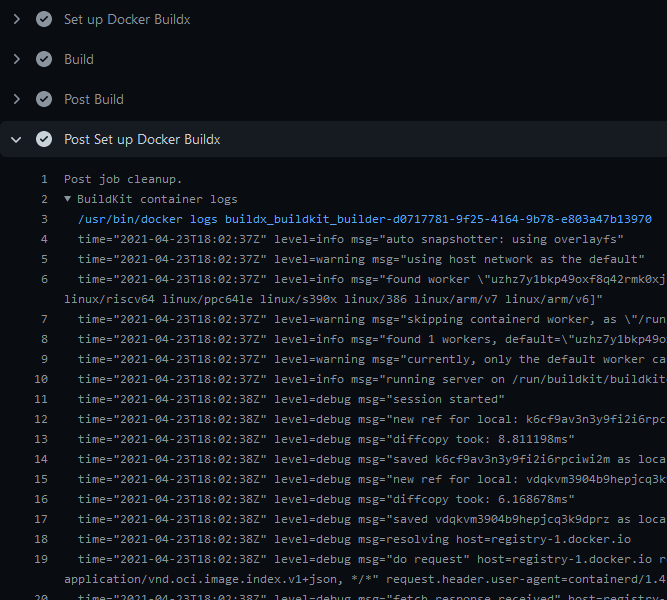If the action is configured to install buildx by default using the input then docker buildx sets up docker build as an alias for buildx making all docker build calls use the buildx builder instead of traditional builders. The action didn't perform cleanup in this case to uninstall the aliases which meant that any future workflows running on same GitHub Actions runner would get the buildx builders even if it did not explicitly request it. This commit tracks if the aliases were installed and removes them during post step of the action if so. Signed-off-by: Ashhar Hasan <hashhar_dev@outlook.com> |
||
|---|---|---|
| .github | ||
| __tests__ | ||
| dist | ||
| src | ||
| .dockerignore | ||
| .editorconfig | ||
| .eslintrc.json | ||
| .gitattributes | ||
| .gitignore | ||
| .prettierrc.json | ||
| action.yml | ||
| codecov.yml | ||
| dev.Dockerfile | ||
| docker-bake.hcl | ||
| jest.config.ts | ||
| LICENSE | ||
| package.json | ||
| README.md | ||
| tsconfig.json | ||
| yarn.lock | ||
About
GitHub Action to set up Docker Buildx.
This action will create and boot a builder that can be used in the following steps of your workflow if you're using
buildx. By default, the docker-container builder driver
will be used to be able to build multi-platform images and export cache thanks to the BuildKit
container.
Usage
Quick start
name: ci
on:
push:
jobs:
buildx:
runs-on: ubuntu-latest
steps:
-
name: Checkout
uses: actions/checkout@v2
-
name: Set up Docker Buildx
id: buildx
uses: docker/setup-buildx-action@v1
-
name: Inspect builder
run: |
echo "Name: ${{ steps.buildx.outputs.name }}"
echo "Endpoint: ${{ steps.buildx.outputs.endpoint }}"
echo "Status: ${{ steps.buildx.outputs.status }}"
echo "Flags: ${{ steps.buildx.outputs.flags }}"
echo "Platforms: ${{ steps.buildx.outputs.platforms }}"
With QEMU
If you want support for more platforms you can use our setup-qemu action:
name: ci
on:
push:
jobs:
buildx:
runs-on: ubuntu-latest
steps:
-
name: Checkout
uses: actions/checkout@v2
-
name: Set up QEMU
uses: docker/setup-qemu-action@v1
-
name: Set up Docker Buildx
id: buildx
uses: docker/setup-buildx-action@v1
-
name: Available platforms
run: echo ${{ steps.buildx.outputs.platforms }}
Install by default
name: ci
on:
push:
jobs:
buildx:
runs-on: ubuntu-latest
steps:
-
name: Checkout
uses: actions/checkout@v2
-
uses: docker/setup-buildx-action@v1
id: buildx
with:
install: true
-
name: Build
run: |
docker build . # will run buildx
BuildKit daemon configuration
You can provide a BuildKit configuration
to your builder if you're using the docker-container driver
(default) with the config or config-inline inputs:
Registry mirror
You can configure a registry mirror using an inline block directly in your
workflow with the config-inline input:
name: ci
on:
push:
jobs:
buildx:
runs-on: ubuntu-latest
steps:
-
name: Set up Docker Buildx
uses: docker/setup-buildx-action@v1
with:
config-inline: |
[registry."docker.io"]
mirrors = ["mirror.gcr.io"]
Max parallelism
You can limit the parallelism of the BuildKit solver which is particularly useful for low-powered machines.
You can use the config-inline input like the
previous example, or you can use a dedicated BuildKit config file from your
repo if you want with the config input:
# .github/buildkitd.toml
[worker.oci]
max-parallelism = 4
name: ci
on:
push:
jobs:
buildx:
runs-on: ubuntu-latest
steps:
-
name: Set up Docker Buildx
uses: docker/setup-buildx-action@v1
with:
config: .github/buildkitd.toml
Customizing
inputs
Following inputs can be used as step.with keys
| Name | Type | Description |
|---|---|---|
version |
String | buildx version. (eg. v0.3.0, latest, https://github.com/docker/buildx.git#master) |
driver |
String | Sets the builder driver to be used (default docker-container) |
driver-opts |
CSV | List of additional driver-specific options (eg. image=moby/buildkit:master) |
buildkitd-flags |
String | Flags for buildkitd daemon (since buildx v0.3.0) |
install |
Bool | Sets up docker build command as an alias to docker buildx (default false) |
use |
Bool | Switch to this builder instance (default true) |
endpoint |
String | Optional address for docker socket or context from docker context ls |
config |
String | BuildKit config file |
config-inline |
String | Same as config but inline |
configandconfig-inlineare mutually exclusive.
CSVtype must be a newline-delimited stringdriver-opts: image=moby/buildkit:masterdriver-opts: | image=moby/buildkit:master network=host
outputs
Following outputs are available
| Name | Type | Description |
|---|---|---|
name |
String | Builder name |
driver |
String | Builder driver |
endpoint |
String | Builder node endpoint |
status |
String | Builder node status |
flags |
String | Builder node flags (if applicable) |
platforms |
String | Builder node platforms available (comma separated) |
environment variables
The following official docker environment variables are supported:
| Name | Type | Default | Description |
|---|---|---|---|
DOCKER_CONFIG |
String | ~/.docker |
The location of your client configuration files |
Notes
BuildKit container logs
To display BuildKit container logs (when docker-container driver is used) you have to enable step debug logging
or you can also enable debugging in the setup-buildx action step:
-
name: Set up Docker Buildx
uses: docker/setup-buildx-action@v1
with:
buildkitd-flags: --debug
Logs will be available at the end of a job:
Keep up-to-date with GitHub Dependabot
Since Dependabot
has native GitHub Actions support,
to enable it on your GitHub repo all you need to do is add the .github/dependabot.yml file:
version: 2
updates:
# Maintain dependencies for GitHub Actions
- package-ecosystem: "github-actions"
directory: "/"
schedule:
interval: "daily"






